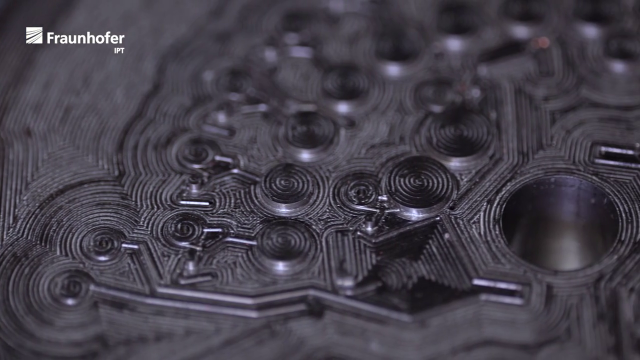Microfluidic components are used in medical applications, in biotechnology, in process engineering, in sensor technology and for consumer goods. Lab-on-a-Chip systems for medical rapid tests or sensors on smart packaging to monitor food freshness are only two of many areas of deployment in which liquids or gases have to be directed through complex microenvironments. Many of these systems have one thing in common: It makes sense to use them only when high-precision and economically efficient microfluidic components are available that can be manufactured in high volumes.
The Fraunhofer IPT develops processes such as step and repeat hot embossing and injection molding processes as well as roll-to-roll processes to apply microfluidic structures to plastics. We use this technologies to produce prototypes with fine channels for pilot applications and mass production purposes. Injection molding is our go-to manufacturing process for chips and discs. We produce surface structures on flexible foil materials in a continuous process using a roll-to-roll system we have developed in-house.
Injection molding microfluidic plastic components
We maintain all the competencies for manufacturing high-precision plastic components under one roof: from component design through tool and mold making to the injection molding process itself. In order to manufacture high-precise mold inserts and tools, we have focused on diamond machining for over ten years, drawing additionally on laser radiation or erosion processes to structure surfaces. We also collaborate closely in the Fraunhofer Project Center for Embedded Bioanalytical Systems with the DCU, Dublin City University, which conducts intensive research on the development of highly-integrated bioanalytical microfluidic platforms. This cooperative partnership provides us with access both to their expertise in microfluidic design that has been acquired by the DCU in many years of research and to their broad range of microfluidic test facilities and environments. By frequently testing the quality of our prototypes throughout bioanalytical tests at DCU, manufacturing processes can be optimized iteratively.
Microfluidics on flexible plastic films
The combination of various modules on our roll-to-roll test facility enables us to continuously structure surfaces. The embossing drums, which we structure ourselves at the Fraunhofer IPT, allow us to achieve structural details measuring anything between a few micrometers to the sub-micrometer range. In addition to this, several layers of film can be brought together in the laminating and coating module to form a multi-layer, multi-functional film. This enables possibilities to combine microfluidic coatings with printed conductor paths in order to electrically stimulate liquids integrated in a flexible film, for example.
Our Service
- Injection molding of micro-fluidic chips and disks
- Structuring of film in roll-to-roll operations
- Producing multi-layer, multi-functional films
- Producing embossing drums, injection molds and injection molding tools
- Developing design and bio-analytical prototype testing within the scope of the Fraunhofer Project Center for Embedded Bioanalytical Systems at Dublin City University (DCU)
- Manufacturing roll-to-roll production lines for microfluidic films



